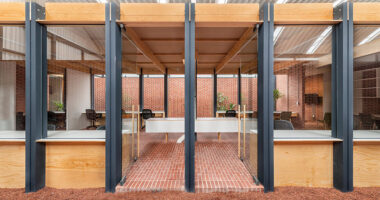Situated in Valle de Uco, Tunuyán, Argentina, Corazón del Sol Winery stands as a testament to architectural innovation in a renowned wine-growing region. Designed by A4estudio, this project embodies a harmonious blend of industrial functionality and tourism appeal.

Industrial Capacity and Tourism Amenities
With a capacity of 70,000 liters in tanks and 50,000 in barrels, Corazón del Sol Winery combines industrial production facilities with tourism-centric spaces. Visitors can explore the wine cellar, indulge in tastings, and access administrative areas alongside witnessing the winemaking process.
Thoughtful Spatial Organization
The winery’s layout follows a strategic organization, with three parallel buildings arranged from east to west: a grape harvesting gallery, a tank room, and a barrel room. This sequential setup ensures efficient production flow, with the fruit entering from the east and the finished product exiting from the north. Tourist entrances are located on the opposite side (west), providing access to a scenic tour designed to offer captivating views of the landscape and mountains.

Harmonizing with the Environment
Corazón del Sol Winery’s architecture harmonizes with its surroundings, with materials chosen to reflect the natural landscape. A concrete base establishes a connection with the mineral-rich ground, while a corten steel skin mirrors the hues of the vineyard during autumn and winter. The tasting room’s terrace, elevated on a piloted platform, offers unobstructed panoramic views, minimizing its environmental footprint.
Sustainable Design Solutions
To mitigate excessive sunlight and regulate interior temperatures, the project incorporates a system of sunshades. These elements not only control light and shadows but also enhance the overall visitor experience, creating comfortable spaces for exploration and relaxation.

Conclusion
Corazón del Sol Winery exemplifies a successful marriage of industrial functionality, architectural elegance, and environmental consciousness. A4estudio’s meticulous design approach transforms this winery into more than just a production facility, offering visitors an immersive journey through winemaking while celebrating the natural beauty of its surroundings.























